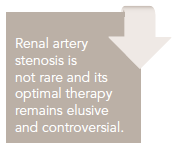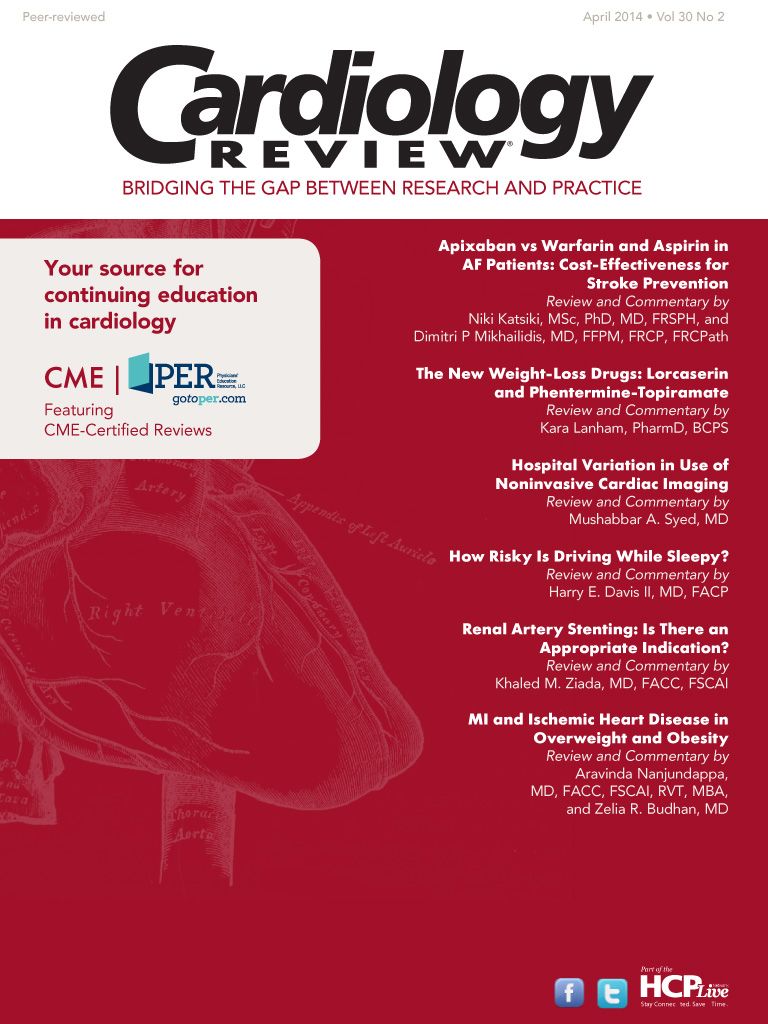Renal Artery Stenting: Is There an Appropriate Indication?
An exploration into the elusive and controversial topic of renal artery stenosis and its optimal therapy.

Khaled M. Ziada, MD, FACC, FSCAI
Review
Cooper CJ, Murphy TP, Cutlip DE, et al. Stenting and medical therapy for atherosclerotic renal-artery stenosis. N Engl J Med. 2014;370:13-22.

Renal artery stenosis (RAS) is not a rare manifestation of atherosclerosis. It is estimated to occur in as many as 7% of patients above the age of 65 years.1 The incidence is higher in patient cohorts with other manifestations of atherosclerosis, for example, those with peripheral and/or coronary arterial disease.2 Fibromuscular dysplasia (FMD) is another less commonly seen etiology of RAS, which usually manifests earlier in life.
Hemodynamically significant RAS leads to renal ischemia, which can present as renovascular hypertension and/or ischemic nephropathy. Renovascular hypertension can be severe, resistant to treatment, rapidly accelerating in older age groups, or malignant with target organ damage. Severe, and frequently bilateral, RAS can present with recurrent episodes of flash pulmonary edema. Ischemic nephropathy presents as gradually worsening renal function. It can also be uncovered when renal function rapidly deteriorates after use of ACE inhibitors. It may be discovered on imaging studies that show a reduction in kidney size. In these clinical settings, imaging studies such as duplex ultrasound, computed tomography angiography (CTA), and magnetic resonance angiography (MRA) can establish the anatomic diagnosis of RAS. If non-invasive tests are inconclusive, direct angiography is needed to obtain higher-resolution selective images of the renal arteries. During these procedures, the pressure gradient across a renal artery lesion can also be measured.3
The optimal therapy for RAS remains elusive. Revascularization of atherosclerotic RAS, typically performed percutaneously, has been controversial and is the subject of this study.
Study Details
The CORAL study (Cardiovascular Outcomes in Renal Atherosclerotic Lesions) is a randomized, controlled trial sponsored by the National Heart, Lung and Blood Institute that sought to define the role of renal artery stenting in addition to optimal medical therapy in patients with significant obstructive atherosclerotic RAS.4 The study randomly assigned 947 participants who had atherosclerotic RAS and either systolic hypertension while taking ≥2 antihypertensive drugs or chronic kidney disease to medical therapy plus renal artery stenting or medical therapy alone. The first patient was randomized in 2005 and follow- up ended in 2012. The primary end point was a composite of death from cardiovascular or renal causes, myocardial infarction, stroke, hospitalization for congestive heart failure, progressive renal insufficiency, or the need for renal-replacement therapy. The individual components of the composite end point represented the secondary end points. At a median follow- up of 43 months, there was no statistically significant difference in the primary end point between those randomized to stenting plus medical therapy versus those on medical therapy alone (35.1% vs 35.8%, P = .58). There were no significant differences between the treatment groups in all-cause mortality or in the secondary end point. There was, however, a modest (2-mm Hg to 3-mm Hg) but significant difference in systolic blood pressure favoring the stent group. The investigators concluded that there was no clear benefit in pursuing stenting for RAS and that medical therapy should be the treatment of choice for those patients.
CommentaryHow Do We Apply CORAL's Findings?
A number of randomized trials of renal artery stenting have been conducted over the last decade, the most significant of which were the Dutch Renal Artery Stenosis Intervention trial reported by van Jaarsveld et al in 2000 and the larger Angiography and Stenting for Renal Artery Lesions (ASTRAL) trial, published in 2009.5,6 The study reported by van Jaarsveld et al randomized 106 patients with hypertension and RAS to balloon angioplasty versus medical therapy. There was no significant difference in hypertension control or renal function between the groups, but the conclusions were criticized due to the high rate of crossover to angioplasty (>40% at 3 months) and the rise of stenting as the treatment of choice for RAS.5 The ASTRAL investigators randomized 806 patients with RAS to stenting plus medical therapy versus medical therapy alone. During 5 years of follow-up, the investigators found no statistically significant advantage for stenting and concluded that the risk of procedural complications was not justifiable.6 However, the study protocol excluded patients with severe clinical presentations who were considered candidates for revascularization and included patients with moderately stenosed arteries, both scenarios biasing the results against the stenting arm. Other limitations included lack of core laboratory assessment of lesion severity, unusually high and severe procedural complications, and use of renal function as a primary end point in a cohort with mostly normal renal function at baseline.
The CORAL trial attempted to overcome the limitations of the previously reported trials. The sample was larger than any renal- artery intervention trial, although the prevalence of those lost to follow-up was relatively high (about 15%). Crossover between groups was highly restricted. The primary end point was a composite of adverse clinical cardiovascular and renal events. All angiograms were reviewed in a core laboratory and all adverse outcomes were adjudicated by an events committee blinded to patient randomization. The contemporary intervention (stenting) was performed in almost all randomized subjects and the complication rate was much lower than reported in other trials.4
Now that CORAL did not show any specific benefit to renal stenting, how does that affect clinical practice? There is no doubt that this well-conducted trial, coupled with the consistency of the results of all randomized trials of renal stenting, clearly demonstrates that the majority of atherosclerotic RAS patients do not need, and do not benefit from, stenting. This in turn brings into question the practice of routinely screening for RAS in hypertensive patients, particularly if blood pressure is well controlled and renal function is normal. It should be clear that the primary and standard of therapy for RAS is medical control of hypertension and secondary prevention of atherosclerosis.
Is there any indication for renal artery stenting? While that is a controversial question, it is important to point out some limitations of the data that currently exist and that may have affected our conclusions regarding this procedure. The basic limitation of the CORAL trial and other trials of RAS has been the accurate identification of hemodynamically significant lesions causing true renal ischemia. It is conceivable—and, in fact, likely—that there is no causal relationship between hypertension and angiographically mild-to-moderate, but hemodynamically insignificant, RAS. Traditionally, angiographic diameter stenosis (typically >50%-60%) has been used to define the threshold of hemodynamic significance, which, as we now know, is far from ideal. Numerous studies of moderately severe lesions in multiple arterial beds (coronary, iliac, cerebrovascular) have shown that lesions of moderate angiographic severity are not necessarily ischemia producing. Unlike coronary stenoses, there are no clear and standardized tests that can detect evidence of renal ischemia with high degrees of accuracy.
As such, patients with lesions of moderate severity on angiography and questionable hemodynamic significance are unlikely to benefit from revascularization, no matter how successful or uncomplicated it may be. Several findings in the CORAL study raise such concerns. The average angiographic diameter stenosis was <70%, with only a minority of patients with stenosis ≥80%. While a noninvasive functional assessment such as Doppler velocity and/or renal aorta ratio may not be accurate enough for entry into the study, it would have been useful to mandate such tests for all study patients and correlate the findings with angiographic stenosis and clinical outcomes.
Typical of all clinical trials that randomize patients after angiographic data are obtained, it is likely that referring physicians and investigators intentionally excluded patients with severe and/or bilateral lesions from randomization because of the inherent belief that such lesions need to be addressed. This becomes more relevant if these severe lesions are found in the context of critical clinical presentations such as recurrent pulmonary edema or malignant hypertension. Therefore, patients more likely to have renal ischemia and thus more likely to benefit from revascularization procedures are excluded from randomization. In CORAL, only one-fifth of the sample had global renal ischemia and/or bilateral disease. It is also unclear whether patients with recurrent pulmonary edema were included, given that a history of recent heart failure was considered an exclusion criterion.
Perhaps the most important observation about the CORAL trial is not what its conclusions were but what it did not address. The overall conclusion is that patients with hypertension and/or renal insufficiency who are found to have RAS should be treated medically. However, the study does not address the issue of those in whom medical therapy fails to control blood pressure or fails to delay progression of renal insufficiency. In fact, the study conclusions do not differ significantly from the existing practice guidelines, which state that medical therapy should be the first line of therapy for hypertensive patients with RAS. The guidelines do go on to suggest that revascularization is reasonable or indicated when medical therapy is not adequate (eg, resistant, accelerating, or malignant hypertension despite therapy with ≥3 pharmacologic agents). The practice guidelines also address and recommend revascularization in clinical scenarios not considered in the trial population, such as patients with unstable angina or congestive heart failure.3
In conclusion, the results of the CORAL trial demonstrated that stenting of atherosclerotic RAS confers no clinical benefit beyond that of optimal medical therapy for RAS patients with severe hypertension and/or chronic renal insufficiency. These data emphasize the role of medical therapy as first-line treatment for this population and raise the threshold for consideration of screening and intervention for RAS. Like other published renal artery intervention trials, the study did not attempt to identify hemodynamically significant lesions and relied heavily on the relatively simple metric of angiographic diameter stenosis for patient selection. In addition, the study did not address clinical situations in which revascularization should be considered, such as failure of medical therapy to achieve goals and the associated critical presentations in RAS patients such as congestive heart failure, recurrent pulmonary edema, and/or unstable angina.
References
1. Hansen KJ, Edwards MS, Craven TE, et al. Prevalence of renovascular disease in the elderly: a population-based study. J Vasc Surg. 2002;36:443-451.
2. Olin JW, Melia M, Young JR, Graor RA, Risius B. Prevalence of atherosclerotic renal artery stenosis in patients with atherosclerosis elsewhere. Am J Med. 1990;88:46N-51N.
3. Hirsch AT, Haskal ZJ, Hertzer NR, et al. ACC/ AHA 2005 Guidelines for the management of patients with peripheral arterial disease (lower extremity, renal, mesenteric, and abdominal aortic): executive summary: a collaborative report from the American Association for Vascular Surgery/ Society for Vascular Surgery, Society for Cardiovascular Angiography and Interventions, Society for Vascular Medicine and Biology, Society of Interventional Radiology, and the ACC/AHA task force on practice guidelines. J Am Coll Cardiol. 2006;47(6):1239-1312.
4. Cooper CJ, Murphy TP, Cutlip DE, et al. Stenting and medical therapy for atherosclerotic renal- artery stenosis. N Engl J Med. 2014;370:13- 22.
5. van Jaarsveld BC, Krijnen P, Pieterman H, et al. The effect of balloon angioplasty on hypertension in atherosclerotic renal-artery stenosis. N Engl J Med. 2000;342(14):1007-1014.
6. Wheatley K, Ives N, Gray R, et al; for the ASTRAL Investigators. Revascularization versus medical therapy for renal-artery stenosis. N Engl J Med. 2009;361(20):1953-1962.
About the Author
K
haled
M. Z
iada
, MD, FACC, FSCAI,
is Gill Foundation Professor of Interventional Cardiology, Associate Professor of Medicine, and Director of both the Cardiac Catheterization Laboratories and the Cardiovascular Interventional Fellowship Program at Gill Heart Institute, University of Kentucky, Lexington, KY.
